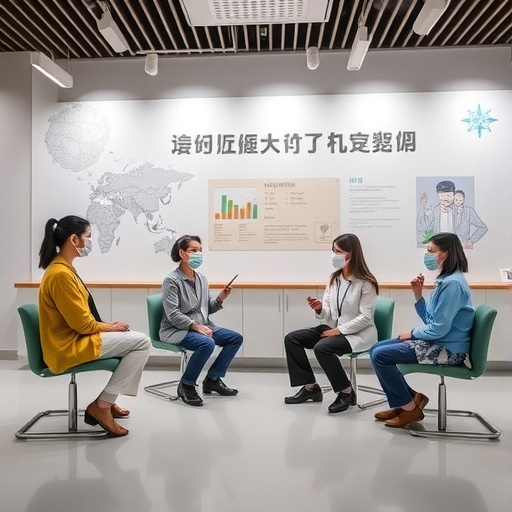
In recent years, the search for targeted therapies against cancer has taken a significant leap forward, especially in the realm of chronic myeloid leukemia (CML). A recent study from an international team led by M.J. Alam and colleagues has shed light on new potential analogues of dasatinib, a drug already pivotal in CML treatment, specifically designed to combat mutated forms of BCR-ABL1, the gene responsible for the majority of CML cases. This groundbreaking research harnesses advanced computational techniques such as virtual screening, molecular docking, and dynamic simulations, proposing novel approaches to the treatment of this challenging disease.
Dasatinib, a multi-targeted kinase inhibitor, has revolutionized the treatment of CML but is not without its challenges. The emergence of resistant mutations in the BCR-ABL1 tyrosine kinase gene mandates the need for new therapeutic strategies. The research by Alam et al. opens a new chapter in the ongoing battle against CML, as these new analogues could offer a means to circumvent resistance mechanisms that render existing treatments ineffective. The study’s focus on finding novel compounds specifically designed to overcome these mutations is particularly significant at a time when there is an urgent demand for new therapies.
The research team employed sophisticated virtual screening processes to identify potential new analogues of dasatinib. This method allows for the rapid and cost-effective evaluation of vast libraries of compounds, dramatically reducing the time needed to find promising candidates for further study. The scientists meticulously analyzed interactions between various compounds and the target protein to ascertain which analogues could effectively bind to and inhibit the mutated BCR-ABL1 protein. The strategic use of computational resources has allowed the team to whittle down thousands of compounds to a manageable few for experimental validation.
Virtual screening is complemented by molecular docking studies, which provide a deeper insight into how the identified compounds interact at the atomic level. This crucial step allows researchers to visualize the binding affinities and the conformational dynamics of candidate molecules once they have docked with the target protein. Alam and colleagues turned to molecular dynamics simulations to further probe these interactions, revealing how the compounds behave in a physiological environment. Such insights are essential in understanding the potential efficacy and safety of the new drug candidates, paving the way for in vivo studies.
Beyond mere identification of new compounds, the research lays the groundwork for identifying specific structural modifications that could enhance the activity of dasatinib analogues while mitigating side effects. This facet of drug design emphasizes the importance of customizing treatments to individual patient profiles, particularly in cancers where genetic variability plays a crucial role in disease progression and treatment response. The detailed structure-activity relationship (SAR) analyses performed in this research will inform future modifications of the drug candidates, providing avenues for even further optimization.
One of the pivotal aspects of this research is the focus on the mutated forms of BCR-ABL1. Targeting these specific mutations is a strategic approach, as most existing treatments are less effective against particular variants. The study argues for a personalized approach to CML treatment, where therapies are tailored not only to the type of cancer but also to the genetic makeup of the individual patient. With this innovative methodology, the authors hope to redefine treatment regimens by providing targeted options that hold the promise of improved efficacy.
As the landscape of cancer treatment continues to evolve, the implications of this research extend beyond CML. The methodologies employed by Alam et al. can potentially be applied to other malignancies characterized by similar genetic mutations. The ability to rapidly screen, dock, and simulate interactions of drugs opens up avenues for researchers across various disciplines to tackle the challenges posed by resistant forms of cancer. It embodies a paradigm shift towards precision medicine, where the treatment is customized based on an individual’s genetic and molecular profile.
Another critical angle explored in this research is the adaptability of the compounds to new mutations that may arise during treatment. The research underscores the importance of developing second- and third-generation tyrosine kinase inhibitors that can stay one step ahead of the mutational landscape. This forward-thinking approach ensures that as resistance develops, the arsenal of available drugs continues to grow, leading to sustained treatment options for CML patients and potentially other cancers.
The findings also underscore the importance of interdisciplinary collaboration in driving innovations in drug discovery. The synergy between computational scientists, structural biologists, and medicinal chemists plays a crucial role in enabling high-throughput drug development. By leveraging the strengths of various scientific domains, the research team has made strides toward redefining the therapeutic landscape for CML, demonstrating the power of collaborative scientific efforts.
As the research community eagerly awaits the experimental validation of the identified compounds, the potential real-world applications of these findings could lead to significant advancements in CML treatment protocols. If validated, these new dasatinib analogues could provide options for patients who have exhausted existing therapies, transforming the prognosis for those battling resistant forms of the disease. The implications of this research reach far into the future, as new combinations of treatments may be devised to improve patient outcomes and quality of life.
In summary, the work by Alam et al. serves as a beacon of hope in the fight against chronic myeloid leukemia and resistant mutations of the BCR-ABL1 gene. Through the innovative application of virtual screening, molecular docking, and dynamic simulations, the research promises to unveil a new wave of targeted therapies. As the scientific community continues to explore the depths of precision oncology, this research is a testament to the potential for computational tools to inform and expand the boundaries of cancer treatment.
Future studies will likely focus on the synthesis and pharmacological evaluation of the newly identified dasatinib analogues. The journey from in silico discoveries to in vivo efficacy is where the true potential of this research will be realized. It shows a concerted effort to utilize technology to address one of the most pressing concerns in cancer therapy: the emergence of drug resistance. The hope is that through focused research and innovative methodologies, the next generation of cancer treatments can be developed, improving outcomes for millions around the world.
With this study, Alam and colleagues have set a solid foundation for further exploration and clinical advancements, marking a notable milestone in pharmaceutical sciences. As new findings emerge from ongoing research, the optimism for effective treatment strategies against chronic myeloid leukemia grows ever stronger, painting a bright future for patients and researchers alike.
Subject of Research: New dasatinib analogues targeting mutated BCR-ABL1
Article Title: Identification of new dasatinib analogues targeting mutated BCR-ABL1: virtual screening, molecular docking, and dynamics simulations studies.
Article References:
Alam, M.J., Jamal, A., Hussain, S.D. et al. Identification of new dasatinib analogues targeting mutated BCR-ABL1: virtual screening, molecular docking, and dynamics simulations studies.
Mol Divers (2025). https://doi.org/10.1007/s11030-025-11310-7
Image Credits: AI Generated
DOI: 10.1007/s11030-025-11310-7
Keywords: dasatinib, BCR-ABL1, CML, virtual screening, molecular docking, drug resistance, targeted therapy, precision medicine, cancer treatment.
Tags: advanced computational techniques in medicinechronic myeloid leukemia treatment advancementsdasatinib analogues for CMLdynamic simulations in cancer researchinnovative approaches to leukemia treatmentmolecular docking for targeted therapiesmulti-targeted kinase inhibitorsmutated BCR-ABL1 gene therapiesnovel compounds for resistant CMLresistance mechanisms in CMLtargeted cancer therapiesvirtual screening in drug discovery




